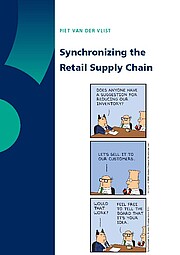Synchronizing the Retail Supply Chain Defended on Friday, 29 June 2007
This thesis is a design of a retail supply chain that is better and cheaper than the usual one. This is achieved by synchronizing distribution to production. Right from production goods should move downstream the supply chain at low cost in full pallets and in full truckloads, in quantities large enough to cover the needs till the next production run. By extending both the Newsvendor- and the EOQ-formulae to a multi-echelon divergent network, it can be proved that such forward positioning of inventory indeed is optimal and that overall supply chain inventories will drop. The suppliers’ warehouses become stockless cross docking points, where goods from the supplier’s various sourcing plants are brought together to consolidate them into full truckloads. Whenever suppliers deliver lower volumes, they better bring these goods to the nearest retailer’s facility; thereafter the retailer himself should move these goods onward to the proper destination within the retailer’s network. And finally shop replenishment should be rationalized based on shelf coverage, so as to enhance the retailer’s warehouse operations.
Keywords
Supply Chain, Synchronization, Inventory positioning, Handling costs, Retail, Consolidation, Vendor managed inventory, Shelf coverage







